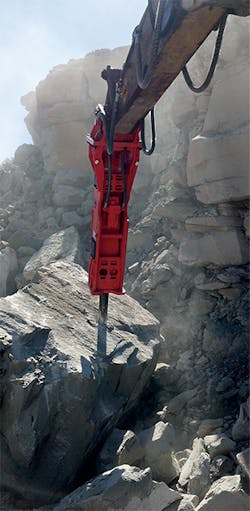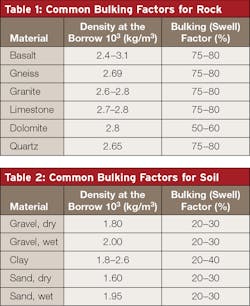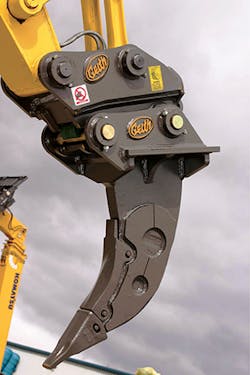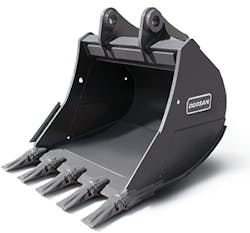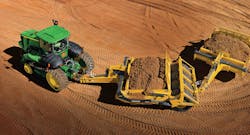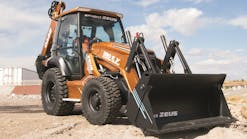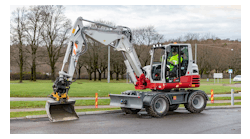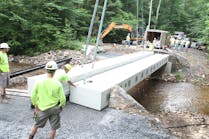Nobody ever said that site work would be easy. For every site with easily excavated soft loamy soils, there is another one with hardpan, rocky soils, frozen soils, or even bedrock. Excavating rock is far harder, more time consuming, and much more expensive than soil excavation. For thistype of operation, special tools are necessary. These tools are often referred to as “ground engaging” tools and include every mechanical means of breaking and removing rock except for blasting.
Hard Rock ExcavationThe Natural Resource Conservation
Service (NRCS) defines rock excavation as follows:
Rock excavation is defined as the excavation of all hard, compacted, or cemented materials that require blasting or the use of ripping and excavating equipment larger than defined for common excavation. The excavation and removal of isolated boulders or rock fragments larger than 1 cubic yard encountered in materials otherwise conforming to the definition of common excavation shall be classified as rock excavation. The presence of isolated boulders or rock fragments larger than 1 cubic yard is not in itself sufficient cause to change the classification of the surrounding material.
What exactly is “rock”? The strict dictionary definition describes rock as “the solid mineral material forming part of the surface of the Earth, exposed on the surface or underlying the soil or oceans.” Rock consists of granite, sandstone, limestone, or similar materials. Rock can be found in solid beds, stratified layers, or as boulders at least one cubic yard in volume or larger. Unlike soil, rock is too hard to simply excavate and has to be removed by drilling, hammering, pneumatic hammers or by blasting. The demolition and removal of concrete pavement and retaining walls is not considered rock excavation, though similar tools can be used for both operations.
The next question to be answered is whether the rock in question is rippable. Rippable rock is the kind of rock that can be removed without blasting. Ripping is either done by ripper attachments to bulldozers or by a hydraulic excavator with a short tip radius rock bucket. According to ISO 6165, such a machine has to be powered by a 120-horsepower engine able to apply a bucket curling force of at least 25,000 pounds and stick-crowd force of 18,700 pounds or greater.
Planning for the possibility of rock excavation is often a necessity on a construction project. A thorough geotechnical investigation of the job site is almost always required. This investigation could the digging of test pits or include soil boring down to bedrock or other rock formation and coring of the rock itself to obtain samples. The number of borings per acre and their depth depends on local conditions, the type of construction to be performed, local codes, and state regulations. Armed with this knowledge, the owner and his engineer can plan for rock excavation and obtain the necessary equipment to do the job.
Contracting and Pricing Issues
It may seem at first glance to be a simple matter to distinguish between rock and soil. But this distinction can be very tricky, especially for purposes of contracting excavation work. For legal purposes, a distinction is made between soil excavation and rock excavation. But this can be ambiguous. Is it hard rock or soft rock? Rippable or non-rippable? To avoid confusion, some contracts simply refer to common excavation (including both rock and soil). Such a contract would also include geotechnical information (boring logs, soil definitions, sample and test results, etc.) to help define the material in question for the contractor. This information in turn helps the contractor determine cost estimates based on assumed productivity rates, duration of effort, types of equipment required, etc.
Why is there such a difference in cost between soil and rock excavation? Strength for one thing. Even the strongest soils have a compressive strength of only 50–60 psi. Rocks, on the other hand, can have compressive strengths 500 times that of the hardest soils (about 25,000–30,000 psi). The amount of energy needed to break and loosen rock is proportionally greater, and so is the resultant cost. Simple excavation can remove soil, but a more sophisticated and powerful technique is required to excavate rock.
It is important at the planning stage to define the payment terms for rock excavation. A contract that utilizes unclassified excavation requires that the contractor will take responsibility for all rock, or other unexpected materials encountered during excavation, at no additional cost. This is a simple approachto costing and does not require the complicated differentiation of soil types, but it puts the full burden for costing the project on the contractor. Classified excavation does differentiate rock layers from soil strata and tries to estimate the volumes of each in the proposed excavation. Here the costing of rock excavation is on the owner, and if he or his geologist/engineer miscalculate the amount of rock the contractor would have every right to submit a potentially expensive change order.
Determining the amount of rock to be removed for planning purposes—and the amount of rock to actually excavate for purposes of billing—can also get complicated. Soil or rock from the borrow expands when deposited in a truck or stockpiled onsite. One cubic yard of soil or rock from the excavation pit increases in volume once it is removed due to its swell or bulking factor. See Tables 1 and 2 for common bulking factors for various types of rock and soil.
The bulking factor represents a percentage increase in volume. For example, 100 cubic yards of limestone with a bulking factor of 80% in an excavation becomes 180 cubic yards when excavated. Or not. Rock and rubble (and broken concrete from demolition jobs as well) can have highly-variable void space volumes that make predicting post excavation volumes no more than a guess. The only alternative to achieve a reasonably accurate estimate of excavated volumes is to go down into the excavation and survey the surfaces of the rock formations both before and after excavation.
A Geith ripper ready for work
Rock Excavation Methods and Productivity
Blasting is the controlled use of explosives to break up rock and allow for subsequent excavation and removal. But blasting is often neither practical or allowed. That leaves mechanical methods of rock excavation: ripping, rock trenching, and hydraulic hammering.
Ripping is a process of breaking up rock and soil with a large tooth or teeth attached to the back of a bulldozer. The heavy version of a ripper would be attached to a large dozer with a minimum 250-horsepower engine. Though more time consuming, ripping is often 50–65% less expensive than blasting. Their functional rating is defined by two factors “pry-out” and “penetration force,” both measured in pounds. The first is defined by the Caterpillar equipment manual as:
The maximum sustained upward force, generated by the lift cylinders measured at the ripper tip. Breakout force is measured with the shank in the top hole, shank vertical and ripper full down. Breakout force may be hydraulically or balance limited.
The second is defined as:
The maximum sustained downward force, generated by the ripper lift cylinders measured at the ripper tip, which is required to raise the back end of the vehicle with the tip on ground and the shank (pinned in the top hole) vertical.
There are three basic types of rippers: adjustable parallelogram ripper, the fixed parallelogram ripper, and radial (or hinged) ripper. A parallelogram ripper has two hinged arms that ensure that the tang of the ripper tooth is vertical or at a constant angle, resulting in superior penetration. The radial ripper is fixed to the bulldozer with a pin, around which the ripper arm rotates. This design results in increased maneuverability. The choice of ripper depends on four factors: downward pressure on tip, horsepower of the bulldozer, weight of the bulldozer, and angle of tooth penetration. The first three factors will be determined by the make and model of the bulldozer being used. The last is a function of the type of ripper.
Doosan’s severe-duty bucket
The function of an hydraulic hammer is to physically break up a rock formation by means of rapid and repeated high energy strikes. Breaking is accomplished with a sharp-tipped hydraulic hammer (also known as a “breaker” or “hoe ram”), designed to break rock and concrete by fracturing its surface on impact, propagating fissures and cracking deep into the material. To maximize applied pressure, the hydraulic hammer is positioned so its movement acts perpendicular to the rock face. The locations of hammer strikes should be placed as evenly as possible on a regular grid pattern to maximize the efficiency of the effort. Once broken, the chunks of rock can be removed by an ordinary excavator bucket.
The ripper can also be combined with an excavator bucket to perform breaking and excavation all in one movement. This design utilizes a minimum of three alternately placed tines along the edge and body of the bucket. Downward pressure and rotational movement breaks the rock and deposits the pieces into the bucket.
Major Suppliers
Since 1985, Antraquip has been a worldwide supplier of hydraulic cutters, road headers, tunnel support systems, and other specialized machinery used in the tunneling, mining, and construction industries. They are a major manufacturer of road headers with interchangeable cutter heads that generate enough force to break materials with uni-axial compressive strength ranging from 500–25,000 pounds per square inch. These cutter heads are custom engineered for individual projects and applications. This customization takes into account the type of rock, the rock’s hardness, and the type of operation. These operations range from rock excavation, trenching, demolition, and concrete to underwater cutting, tunneling, and scaling. The cutter heads are driven by high-torque hydraulic motors with drive systems comprising durable spur gears. Their transverse cutters are hydraulic attachments for excavators and other earthmoving equipment, operating with low vibration and noise generation. Models range from 1–150 tons. Their axial hydraulic cutters are designed for ease of use in tight confines such as trenching operations as well as remediation, profiling, scaling surfaces, and controlled demolition. They range in size from 3–50 tons.
Doosan Infracore Construction Equipment America (commonly known as Doosan) markets the Doosan brand of products that includes large crawler and wheel excavators, wheel loaders, and articulated dump trucks. It has a new line of severe-duty buckets for crawler excavators. This new bucket is designed to handle abrasive materials in heavy digging and loading applications. Approved for use with their Doosan DX140LC-5 through DX530LC-5 crawler excavators, they are available in a pin-on or wedge-lock style. They range in size from 18 inches wide to 72 inches wide. Made of an abrasive resistant material, their severe-duty buckets include side cutters, shell bottoms, and side wear plates. Strengthened gussets and a welded attached wear shroud add to their operational lives. Front wear pads can be added for rock excavating work. These cover thicker cutting edges designed for working in hard rock. Also standard are abrasion-resistant rolled wear straps.
The Hercules Machine Corp. is a supplier of rock hammers as well as the owner of the largest rental fleet of foundation equipment in the Midwest. They sell and service a full line of diesel, air/steam, and vibratory hammers. This product line includes their own designed and manufactured Movax Sonic Side Grip Vibratory Pile Driver. Their new Hercules Hydraulic Hammer (H3) is designed for flexible application and efficient, time-saving operations. With a running position of 13.25 feet, the H3 is easy to transport and maneuver, especially in tight areas with low head room. It is excavator mounted and hydraulically-powered, delivering 28,000 foot-pounds of energy with a 3,000-pound ram operating with a 4-inch stroke at 15 blows per minute. It comes with multiple drive head options depending on the type of material encountered (H-beam, sheeting, or timber).
Leading Edge Attachments Inc. produces the Multi-Ripper SHARC product line, add-ons that break rock and frozen soil four times faster than a hammer at less cost. A new addition to their SHARC product line is their Multi-Ripper Talon Bucket. Operating on the same principal as their Multi-Ripper Bucket, this bucket is very narrow and rips both the sides and bottom of a trench flat, working smooth without depth limitation. Strategically placed staggered shanks on an arc hit the rock in sequence, applying maximum breakout force to each tooth one at a time. Since the shanks are short, each tooth can deliver about 8.5 times the force of a standard five-tooth bucket. Their even placement allows them to rip a flat bottom to the trench. Designed primarily for utility trenching in rocky soils, its redesigned leading edge allows for elimination of a center rib, greatly improving capacity fill and dumping for such a narrow bucket. Its utilization avoids the need for rock trenchers, hammers, and blasting. While operating, the Multi-Ripper Talon Bucket utilizes their patented SHARC Technology. This allows the bucket to perform similarly to a trencher while using the hydraulic excavator’s rolling action to rip through the rock.
NPK Construction Equipment Inc. offers a choice of eight backhoe models (GH-06 through GH-7) with impact energy class ratings of 2,500 pounds. Designed to work with these excavator models is their new PH-Series Hydraulic Hammers equipped with an “easy to switch” anti-blank firing system. They have lower weights, which provide better balance for their carrier equipment and simplified maintenance. They come equipped with soundproof brackets enclosing the hammer along with a new valve system, slip fit tool bushing, larger retainer pin, and a side bolt-free casing. Their hydraulic hammers are designed with a larger piston to sleeve bearing area with improved lubrication. This allows for expanded seal life for the driving piston. With only two moving parts, this design avoids the need for bladder type accumulators and the resultant high maintenance costs. And with shock-absorbing mounting systems (brackets that use special heavy-duty rubber mounts to absorb shock, recoil, and impulse vibration) they are capable of high production rates even in hard rock. This shock absorption reduces noise levels and increases operator comfort (an often overlooked aspect of workplace productivity). For their size, the NPK “GH” series has the most powerful hammers in the industry. Starting with the GH-06 with impact energy rated at 150 foot-pounds, their product line increases in power until the GH-50 with an impact energy rating of 20,000 foot-pounds.
OSA Demolition manufactures advanced hydraulic breakers. Their HM (high manufacturing) series allows for manual variation to the frequency and energy of the strikes. So in response to encountering very hard material, an operator can manually adjust the breakers’ operation to deliver fewer strikes with increased energy. In less hard material, an operator can manually adjust the system so that the breaker delivers more frequent but lower energy strikes. The ability to manually vary the strikes is coupled with an integrated hydraulic system, which cancels empty strikes. As a result, the operator can avoid breaking tools, pin retainers, and pistons. An intelligent system, it can sense when the chisel head is on hard material. At that point, the hydraulic breaker piston is activated. But when it comes into contact with soft material the piston won’t move, avoiding time wasting empty strikes. This minimizes wear and tear on the equipment by preserving tie rods and bushes, as well as on people by reducing the vibrator impact to the operator. Its shock absorber system keeps the noise generated by the chisel lower than legally established limits. Its dust protection system prevents intrusion on the parts inside the hydraulic breaker, greatly increasing its operating life while minimizing maintenance requirements.
Rockland Mfg. makes rock ripping buckets with modified spade nose lips and a set of three staggered teeth. This configuration of welded ripper shanks optimizes ripping action, allowing maximum penetration with each cut. Along with the teeth, the buckets can come with AR400 lightweight, high-strength, abrasion-resistant alloy steel side cutters and full body wear plate for long-term durability. Specialized operations in tightly packed, high-density frozen soil, caliches, limestone, other fracturable shale like rock or other rocky soils are provided by the Rockland V-Bottom/Frost bucket. Also constructed of AR400 steel, it has teeth are adapted to these special soil characteristics. Another harsh excavation condition can be encountered during coal mining. To meet this challenge, Rockwell has developed its Coal Stripping (CS) buckets. It comes with staggered teeth and welded side cutters. With a high profile and wide stance, its efficient design can increase coal pit production rates.
Geith rippers are designed to add powerful ripping ability to your excavator in the most demanding hard ground and demolition applications. Geith rippers are engineered for use with excavators ranging in size from 4–80 tons. Especially useful on tough, hard-packed, and frozen ground, the ripper is also a cost-effective and low-maintenance alternative to hydraulic hammers and rock removal in areas where blasting is prohibited. Standard design features include a replaceable tooth and wear shroud, reinforcing gussets, and side wear protection plates. All of the features are designed to extend the life of the ripper. A heavy-duty steel shank further increases ripping force at the point of application. When combined with the Geith quick coupler, operators can quickly switch from ripper to bucket from inside their cabs.